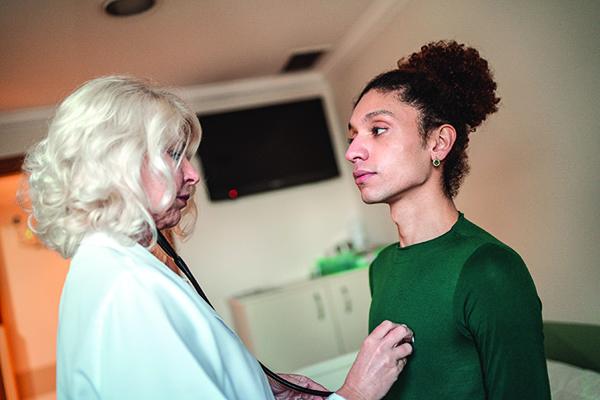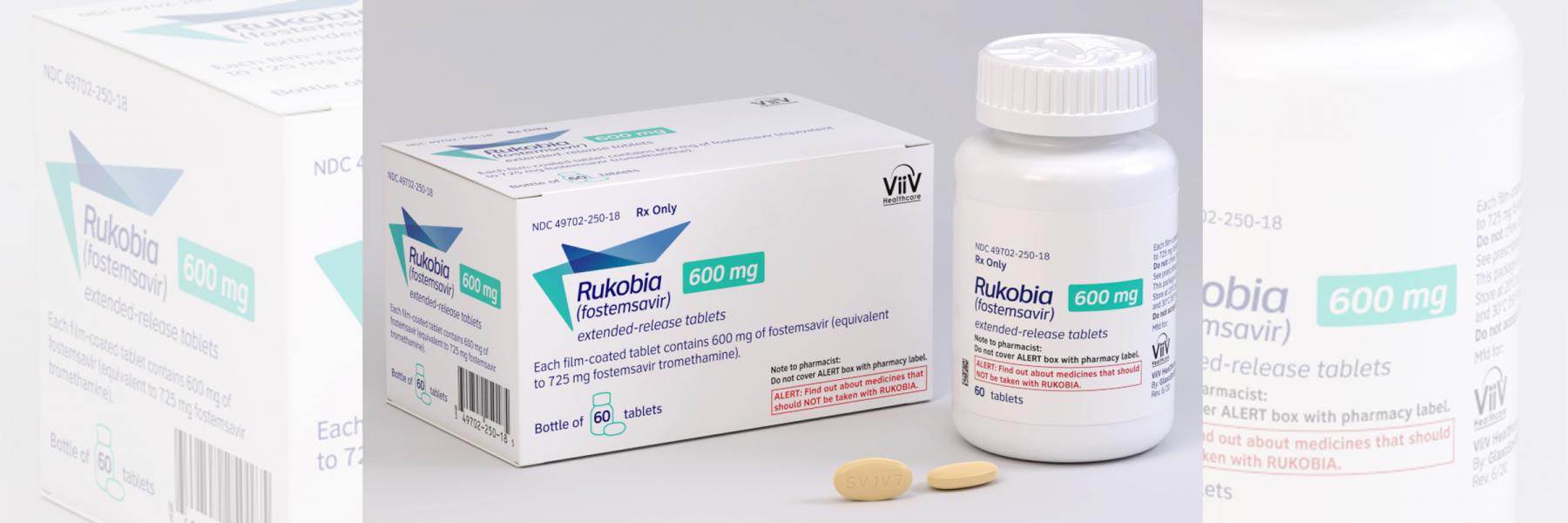
FDA approves new HIV drug for people with limited treatment options: Rukobia
The U.S. Food and Drug Administration (FDA) has approved a medication for multi-drug resistant HIV that is the first of its kind on the market, Rukobia (fostemsavir). Rukobia is very different from other HIV medications in several ways.
First, Rukobia was approved for people who are:
• heavily treatment-experienced
• with multidrug-resistant virus
• on a failing regimen due to resistance, intolerance, or safety considerations
Rukobia is also the first HIV drug of its type on the market. It is a gp120 attachment inhibitor. As such, it is part of the HIV entry inhibitor group of drugs, all of which are used for heavily treatment-experienced people.
“This approval marks a new class of antiretroviral medications that may benefit patients who have run out of HIV treatment options. The availability of new classes of antiretroviral drugs is critical for heavily treatment-experienced patients living with multidrug resistant HIV infection—helping people living with hard-to-treat HIV who are at greater risk for HIV-related complications, to potentially live longer, healthier lives,” said Jeff Murray, MD, in a press release. Dr. Murray is deputy director of the Division of Antivirals of the Center for Drug Evaluation and Research at the FDA.
The FDA approval of Rukobia on July 2 was expedited under the agency’s Fast Track, Priority Review, and Breakthrough Therapy Designation for new drugs to address unmet medical need of treatment in serious or life-threatening conditions.
As noted in the Positively Aware annual HIV Drug Guide, “Fostemsavir works on the gp120 protein that lies on the surface of human immune cells. It’s a necessary part of getting the virus to enter the cell. Fostemsavir prevents attachment to the CD4 immune cell by binding to the CD4 receptor binding sites on gp120 on the virus. This causes the virus to accumulate in extracellular space and is subsequently removed by the body’s immune system. Very cool.”
Inside the body, fostemsavir first converts into the drug temsavir, which then attaches to the glycoprotein 120 (gp120). This makes fostemsavir a prodrug of temsavir, basically, a drug that converts into another drug in the body. Because fostemsavir is the first drug to target this step of the HIV life cycle, no resistance to other classes of antiretrovirals is expected.
Watch a video of Rukobia’s mechanism of action at youtu.be/WnreXE-TVi8.
Rukobia is dosed as a 600 mg tablet taken twice daily with or without food. It must be taken in combination with other HIV antiretrovirals (ARVs).
The FDA’s approval was based on Phase 3 data from the BRIGHTE study. A group of 272 participants received fostemsavir plus one or two other active new drugs on top of their failing regimen. For this group, 60% had undetectable viral load (less than 400) at 96 weeks, with an average T cell increase of 205. For the group of 99 participants who only added fostemsavir plus—in some cases—an active investigational drug, 37% had viral load less than 40 at 96 weeks, with an average T cell increase of 119.
The most common side effect seen in clinical trial was nausea (10%). About 7% of participants stopped treatment because of adverse reactions; the most common were nausea, fatigue, and diarrhea. Serious drug reactions were experienced in 3% of fostemsavir recipients, which included three cases of severe immune reconstitution inflammatory syndrome (IRIS), and elevations in liver enzymes in participants in who also had hepatitis B or C virus. IRIS, a sign of returning immune system strength, is not uncommon in people with advanced HIV disease who begin taking powerful antivirals. Symptoms of disease should be discussed with your doctor.
Among the BRIGHTE participants, about 75% were men, 60% were over age 50, nearly 30% had a viral load above 100,000, 71% had been treated for HIV for more than 15 years, and 85% had been on at least five different drug regimens.
Rukobia is contraindicated with (cannot be used together) strong cytochrome P450 (CYP)3A inducers, which are drugs that include enzalutamide (an androgen receptor inhibitor); carbamazepine and phenytoin (anticonvulsants); rifampin (an antimycobacterial, used for tuberculosis); mitotane (an antineoplastic, used for cancer); or the herbal St. John’s wort.
—with Rick Guasco
For more information
Go to positivelyaware.com/fostemsavir. FDA news release: fda.gov/news-events/press-announcements/fda-approves-new-hiv-treatment-patients-limited-treatment-options
Announcement: bit.ly/FDAannouncementRukobia.
Prescribing information: bit.ly/RukobiaPrescribingInfo

HIV prevention drugs now available without first-time prescription in California
California has become the first state in the U.S. allowing pharmacies to sell HIV prevention drugs without a prescription under a new state law that took effect July 1.
Pharmacies in California can now sell up to a 60-day supply of PrEP for pre-exposure prophylaxis or a 28-day course of PEP for post-exposure prophylaxis treatment without a prescription from a medical care provider.
After that, a doctor’s prescription will be required, but the new law also prevents insurance companies from requiring prior authorization to pay for the drugs. Medi-Cal, the state’s version of Medicaid, is also now required to cover PrEP and PEP.
Before receiving PrEP or PEP, under the law, a person must show proof that they have tested negative for HIV in the previous seven days. It is necessary to test for HIV before starting PrEP because if a person with HIV takes PrEP, their virus could develop resistance to the drugs that are also used in some HIV medications, potentially limiting a person’s future treatment options. It’s also important to have regular check-ups while taking PrEP to test kidney function and to test for sexually transmitted infections.
PEP is used to prevent an HIV infection that may already be in progress, so no HIV test is needed.
The law also requires pharmacists to educate patients about PrEP—including side effects, the importance of adherence, additional testing, and about other infections such as HIV, hepatitis B, and hepatitis C. Pharmacists must also discuss additional safety information about PrEP use during pregnancy and breast feeding.
The new law’s restrictions are the result of a compromise. The California Medical Association and other medical groups had originally opposed the bill’s passage, concerned about the long-term use of PrEP and PEP without follow-up testing and medical supervision.
Signed into law last October by Gov. Gavin Newsom, Senate Bill 159 was authored by state senator Scott Wiener and co-sponsored by assemblyman Todd Gloria. In 2014, as a member of the San Francisco Board of Supervisors, Weiner disclosed that he was taking Truvada as PrEP. Weiner chairs the LGBTQ caucus of the California state legislature.
—Rick Guasco
Methadone take-homes during COVID shutdowns
For decades, advocates have fought the hardships faced by patients forced to travel to a clinic on a daily basis to take their methadone treatment. The thought of a natural disaster struck terror into patients who would get sick from withdrawal if they were unable to go to the clinic.
Opioid treatment programs (OTPs) reported good results with giving patients multiple doses to take home in the face of COVID-19 shutdowns, AT Forum reports.
Read the article at atforum.com/2020/07/extended-methadone-take-homes-during-covid-nothing-but-success.
A free newsletter, Addiction Treatment Forum is available only online; it’s a must-read for anyone interested in issues of treatment and justice surrounding drug use. Go to atforum.com.
Supreme Court upholds anti-prostitution pledge
“When it comes to sex workers in the U.S. and around the globe, many of whom are Black, Brown, and transgender, discrimination and criminalization of sex work have put them at a high risk of violence, contracting preventable diseases like COVID-19 and HIV, and have exposed them to police brutality. Yet the U.S. continues to weaponize lifesaving global AIDS assistance programs against sex workers by demanding recipients of PEPFAR funding to officially adopt a position opposing prostitution and acquiesce to the U.S. conflation of sex work and trafficking. The Supreme Court has just ruled in favor of the Anti-Prostitution Loyalty Oath (APLO), a provision in the 2003 United States Leadership Against HIV/AIDS, Tuberculosis, and Malaria Act, that required all recipients of funding through the President’s Emergency Plan for AIDS Relief (PEPFAR) to “have a policy explicitly opposing prostitution,’” writes Serra Sippel Bergen Cooper in the Washington Blade. Sippel is president of the Center for Health and Gender Equity (CHANGE), and Cooper is director of policy research at the organization. CHANGE is a human rights organization advocating for sexual and reproductive health and rights.
The pledge has been a thorn in advocates’ side since the creation of PEPFAR in 2003. Or as Sippel and Cooper note, “The APLO is and always has been a bad policy.” The court ruling was made in July.
Read the opinion piece at washingtonblade.com/2020/07/17/anti-prostitution-loyalty-oath-undermines-hiv-fight. Learn more at srhrforall.org.
Long-time HIV advocates join U=U campaign
Three long-time HIV advocates have joined Prevention Access Campaign (PAC) to help promote PAC’s Undetectable Equals Untransmittable (U=U) campaign.
Davina (“Dee”) Conner has signed on as PAC’s U.S. creative engagements and outreach specialist; Deondre B. Moore as U.S. partnerships and community engagement manager; and Esther Dixon-Williams, as coordinator of global affairs.
“Dee, Deondre, and Esther bring decades of collective experience and an understanding of communities that will strengthen our social and racial justice work,” said Bruce Richman, PAC’s founding executive director.
Cameron Kinker, who has been PAC’s community engagement coordinator, will become the U.S. program and communications manager. Murray Penner remains as U.S. executive director, with Richman continuing to oversee the growing international campaign.
The full announcement is at bit.ly/pacstaff820.

Provider=Prevention for U=U
No matter the advances in HIV, stigma always remains a problem. Ironically, this applies to the medical profession as well.
But the medical profession confronts the issue. Researcher Sarah K. Calabrese, PhD, an assistant professor at George Washington University, in Washington, DC, and HIV specialist Kenneth H. Mayer, MD, of Fenway Health, in Boston, recently published a paper outlining stigma surrounding U=U in provider communications with patients. More importantly, they created strategies to help health care systems fight stigma around HIV prevention.
“U=U” is a community-driven campaign message spreading the word that “undetectable equals untransmittable.” A person living with HIV is unable to transmit the virus to sex partners when their viral load is undetectable (under 200 copies) on stable therapy for at least six months and in the absence of any other STI. In medical terminology, this fortuitous by-product of successful HIV therapy is called “treatment as prevention” (TasP).
“There has been a notable challenge around consistently communicating the discovery that sustained viral suppression eliminates risk of sexual transmission (undetectable = untransmittable, U = U) to patients,” Calabrese and Mayer wrote. “Failure to routinely incorporate U = U patient education into clinical practice is peculiar because the U = U message aligns with treatment goals. Moreover, it is providers’ professional responsibility to inform patients of treatment risks and benefits. So why aren’t these conversations happening? Although there are multiple contributing factors, including structural challenges that vary by setting (e.g., time limits on patient visits), we contend that stigma—that is, social devaluation based on one or more distinguishing characteristics—could be a key reason underlying the lack of consistent U = U patient education.”
Some other considerations mentioned include lack of knowledge; fear of being blamed if transmission occurs; and concerns about risk compensation, the idea that people may take greater risks than they normally would.
Calabrese and Mayer created four overarching categories for fighting stigma against U=U discussion:
1. “Establish universal U=U patient education in normative guidelines dictating clinical practice
2. “Incorporate U=U into clinical education for all HIV service providers
3. “Facilitate patient-provider conversations about U=U with concrete tools
4. “Broaden public awareness through public health messaging”
There are steps to take under each item along with informative messages. For example, establishing professional standards could indicate substandard care if the U=U message is not provided. Public education is important because it can reach people who are not receiving medical care as well as those who have difficulty accessing it. It can also encourage some people to go see a doctor.
The authors also note that HIV treatment guidelines from the Department of Health and Human Services now expressly state that, “All persons with HIV should be informed that maintaining a plasma HIV RNA (viral load) [less than] 200 copies/mL … prevents sexual transmission of HIV to their partners.”
It’s a message that may not be heard above the stigma.
“It is not only the discretionary nature of U = U education as a clinical activity that renders it vulnerable to stigma; it is also the patient populations impacted and behaviors associated with HIV transmission that may be stigmatized in and of themselves,” wrote Calabrese and Mayer. “Worldwide, people living with HIV have been mistreated in healthcare, facing providers who refuse to treat or provide substandard treatment. This is consistent with stigmatizing attitudes towards patients with HIV that providers have endorsed, including stereotypes related to sexual irresponsibility. Given the concerns related to risk compensation that providers have reported as reasons for not discussing U=U, these preconceived notions about patients living with HIV may reinforce existing concerns and potentiate stigma. People living with HIV who have other, intersectional marginalized statuses (e.g., men who have sex with men or people who inject drugs) may be more likely to be stereotyped as irresponsible or at risk, further exacerbating providers’ concerns about the consequences of U = U discussions and fueling disparities.”
Read the article, including footnotes, published online July 19 in the Journal of the International AIDS Society at bit.ly/UequalsUstigmaJAIDSarticle.
Dovato receives switch indication
The HIV medication Dovato can now be taken by people switching over from another HIV regimen. Previously, individuals had to be new to HIV therapy (treatment-naïve) in order to take it.
Dovato is a complete HIV regimen in one pill (a single-tablet regimen, or STR). Switching to Dovato, an individual must have undetectable viral load (less than 50) on their current HIV regimen, with no history of treatment failure or drug resistance to the medications in Dovato. Dovato contains dolutegravir, an integrase inhibitor, and lamivudine (3TC), a nucleoside reverse transcriptase inhibitor (NRTI).
Lamivudine, used as a background drug for more powerful HIV medications, has practically no side effects. The powerhouse dolutegravir, however, has been associated with distressing weight gain. HIV treatment-related weight gain is becoming more recognized and is being researched.
Dovato’s drug label was also updated with 96-week safety data. The percentage of individuals who discontinued Dovato due to adverse events had increased from 2% to 3%. At 96 weeks, anxiety was added to the potential side effects that may occur with Dovato. It was observed in 2% of study participants taking the STR.
Read the August 8 FDA announcement at bit.ly/DovatoSwitchAnnouncement; go to positivelyaware.com/dovato.
New pediatric approval for Evotaz and Prezcobix
For the third time this year, the U.S. Food and Drug Administration (FDA) has expanded the availability of HIV medication for pediatric use.
Children can now use these two-in-one combo pills:
• Evotaz (atazanavir/cobicistat) or
• Prezcobix (darunavir/cobicistat)
Children must weigh at least 77 pounds (35 kg) to use Evotaz and at least 88 pounds (40 kg) to use Prezcobix.
The approval basically formalizes the use, since children could already use the drugs in Evotaz or Prezcobix separately (Reyataz plus Tybost or Prezista plus Tybost). The FDA’s July approval means kids can officially be given one of the combo pills instead.
Evotaz and Prezcobix are each taken as one tablet once daily with food and must be taken with at least one other HIV drug. They can be taken by people using HIV therapy for the first time or those who are already HIV treatment-experienced. The side effect profile for each medicine is similar to that seen in adults.
As with adults, children taking Prezcobix cannot have darunavir-associated drug resistance.
Read the FDA announcement, which includes pediatric clinical trial data, at bit.ly/pediatricEvotazandPrezcobix. Read more at positivelyaware/evotaz and positivelyaware/prezcobix.
Long-acting injectable cabotegravir submitted to FDA
The treatment activist group HIV i-Base, in London, reported the re-submission of long-acting injectable cabotegravir (CAB-LA) to the FDA for approval. The filing was not reported by the drug maker in the U.S. Indeed, the long financial report from pharmaceutical giant GSK, headquartered in England, said simply: “Cabenuva resubmitted in the U.S. as HIV treatment; regulatory decision anticipated Q1 2021.” That is to say, the new medication may be approved in the first quarter of next year.
The company also noted in its July update that, “Positive data from the CUSTOMIZE trial, the first ever implementation research study on how best to integrate an investigational once-monthly injectable HIV treatment in U.S. healthcare practices, were presented at AIDS 2020.”
Cabenuva is the name for the CAB-LA injectable plus long-acting rilpivirine (RPV-LA) injectable for HIV treatment. The complete HIV regimen is to be given as two shots every four weeks.
HIV i-Base writer Simon Collins notes that, “It is good that a regulatory decision is closer given the high expectation among HIV positive people for an alternative to daily tablets. Access though in many countries will be dependent on price.”
In the U.S., GSK long ago put all of its HIV drug development into a new subsidiary company, ViiV Healthcare. ViiV received FDA approval of a new HIV medication, Rukobia, in July, which was also noted in the GSK report. Go to i-base.info/htb/38707 and positivelyaware.com/la-cab-rpv.
CDC expands hep A vaccine recommendation
The Centers for Disease Control and Prevention (CDC) now recommends the hepatitis A vaccine for everyone over the age of 12 months. Read the updated recommendations published July 3 in the Morbidity and Mortality Weekly Report.


